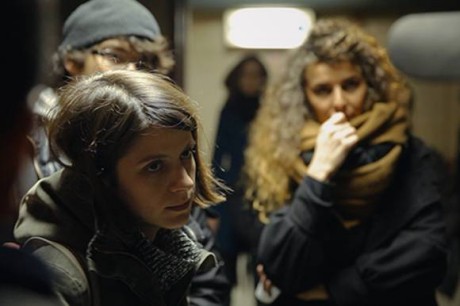


Senka Domanović: Occupied Cinema

… and a review of the third film praised by Sarajevo FF documentary programmer, Rada Sesic who in her catalogue foreword writes: … The debut feature length film by Serbian new talent Senka Domanovic, Occupied Cinema, with which we open our Competition section, succeeds so well to show not only the drama of the months-long protests against the closing of the oldest Belgrade cinema but to reflect the temperature of the society, especially among the urban young population…
I agree with the programmer, it’s a powerful film that makes me sad and (a
bit) optimistic at the same time. Sad because the occupation ends with a split up among the occupants, a broken dream, optimistic because all that positive energy must not disappear, if political changes should happen in Serbia or am I now the naïve outsider, who has visited Belgrade once per year since year 2000 listening to friends describing the current situation as hopeless, watching Mila Turajlic’s great “The Other Side of Everything” and seeing how privatization is being performed as it so strongly is demonstrated in “Occupied Cinema”.
A good documentary needs several layers and a clear storytelling structure. Domanović, in this first long documentary, masters both, together with the cinematographer Sinisa Dugonjic and Mina Nenadovic, the editor. It is observational cinema, mixed with interviews and comments by some of the activists – those from the “occupied cinema movement” and those, who are activists, including workers from the Beograd Film that owned this and around 10 other cinemas in the city before they were privatized, sold to businessman Divanovic, who in the film via a phone contact says that he can do nothing as the tax authorities have closed his business – after he was in prison for corruption, if I got it right.
Never mind… the film, “occupation in 4 chapters”, shows the enthusiasm among the occupiers from the beginning, where there were people sleeping on location, where a film by Mina Djukic (photo) were shown as the first, where concerts were held, where two meeting rooms were organized and the endless discussions started about what the cinema should be, for films only, for cultural activities including production, and who should be the target audience?
Zvezda is the name of the downtown Belgrade cinema, it means Star, and there are wonderful small clips from the time where the cinema worked, with an outdoor cinema on the roof, Jean-Paul Belmondo was there, on film, “A Bout de Souffle”, a poster on the wall says so. We need to have self-management but how, “time for a vision” is the title for the second chapter, it goes in the direction of chaos, one says “there was a lot of energy… but we didn’t learn how to manage it”, and the film shows that, leading to (title of third chapter) division and yet there is still time for celebration of 100 days of occupation – and later of the one year in the final chapter that carries the question “where is the revolution” including a clip from the selling of the classic Yugoslav Avala Studios and its assets – 200 feature films and 400 documentaries!… So well described in Mila Turajlic’s “Cinema Komunisto”.
For one who is old enough to remember 1968 and similar actions that ended up in division as well, because of ideology, there is lot to recognize, the film has definitely a universal appeal because it is so well made and shows in a fine way the will and effort to change and how the young activists succeeded to make a cinema with a lot of activities – and how the energy and solidarity did not sustain. Put in the perspective of a country that invites any kind of capitalistic investments to happen. As in so many other countries…
Serbia, 2018, 87 mins.